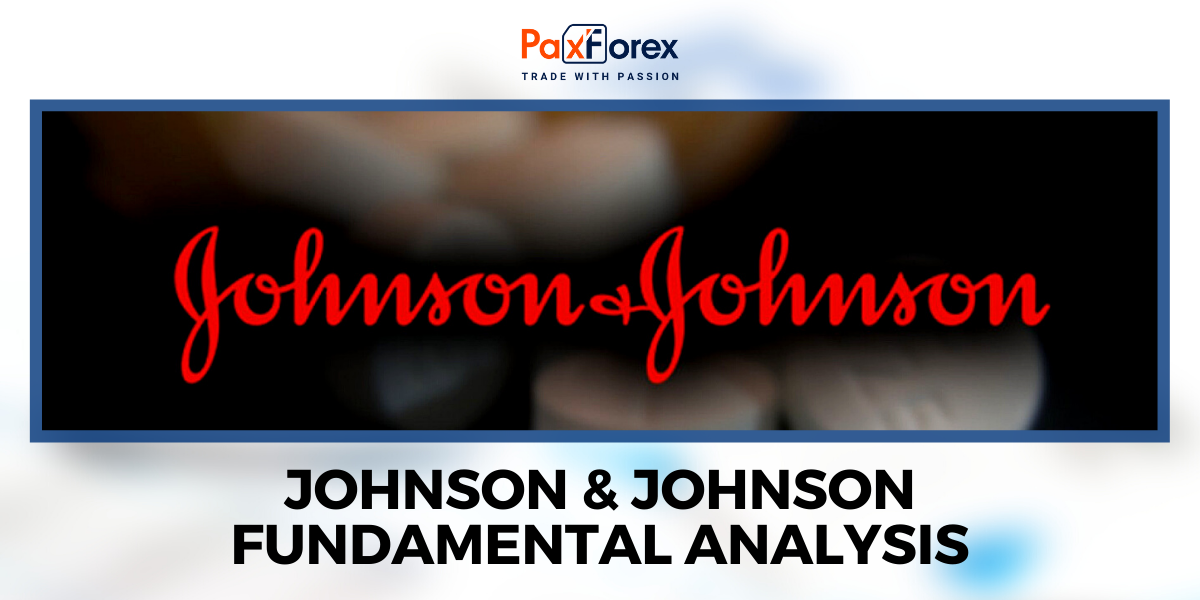
Source: PaxForex Premium Analytics Portal, Fundamental Insight
You're likely familiar with Johnson & Johnson, a household name thanks to products like Band-Aid bandages and Tylenol that may reside in your medicine cabinet. However, these well-known products, which once defined J&J, are no longer part of the company's core operations. Recently, J&J made a significant move by spinning off its consumer health unit into a new entity known as Kenvue.
This strategic decision has reshaped J&J's focus, leaving it with two primary businesses: pharmaceuticals and medtech. As a consequence of this transition, J&J has adjusted its sales and earnings per share guidance for the year to account for the absence of consumer health earnings. This shift has sparked discussions about whether J&J remains an attractive investment in this new growth-oriented era. The revised earnings forecast might prompt some hesitation. So, the question arises: Is J&J a wise investment choice following the separation from Kenvue? Let's delve into this matter.
First, let's assess J&J's performance in the context of the former consumer health unit. While this unit featured popular products widely used by consumers, it had been exerting a drag on J&J's overall annual growth. To illustrate, consider last year's earnings: While the pharmaceutical and medtech segments each achieved sales growth of over 6% on an adjusted operational basis, consumer health sales increased by less than 4%.
Furthermore, consumer health represented a notably smaller portion of the company's overall sales. In the previous year, it contributed approximately $14 billion, while pharmaceuticals and medtech generated $52 billion and $27 billion, respectively.
The separation of consumer health from the company carries significant advantages for J&J. It eliminates a slow-growing business from the earnings equation, consequently bolstering the reported sales growth figures. More importantly, it empowers J&J to channel its resources more effectively into its high-growth sectors. Rather than allocating investments across consumer health, J&J can now allocate all of its resources to further fuel the growth of its pharmaceuticals and medtech divisions. This strategic realignment positions J&J to capitalize on emerging opportunities and pursue innovation with greater focus and vigor.
Speaking of resources, the separation of Kenvue has not only reshaped J&J's strategic landscape but also injected substantial capital into the company. The Kenvue operation itself generated proceeds exceeding $13 billion for J&J. This significant sum presents a wealth of opportunities for J&J, enabling the company to bolster its internal pipeline, foster growth through collaborations, and pursue strategic acquisitions. During J&J's latest earnings call, the company expressed its "voracious" appetite for business deals and emphasized that "external innovation" comprises approximately half of its pipeline.
A compelling illustration of J&J's prowess in acquisitions is its purchase of heart pump specialist Abiomed last year. This strategic move added a 12th platform to J&J's medtech portfolio, a segment that already generates annual sales exceeding $1 billion. Notably, Abiomed's sales have demonstrated remarkable double-digit growth in the most recent quarter, underscoring the success of J&J's acquisition strategy.
Now, let's turn our attention to the immediate aftermath of the Kenvue spinoff. J&J's new full-year sales guidance, excluding the consumer health unit, centers around $83.6 billion at the midpoint. This figure stands in contrast to the previous forecast, which included the consumer health unit, with a midpoint of $99.3 billion. Additionally, the earnings midpoint declined to $9.95 per share from $10.65, based on an adjusted operational basis.
It's worth noting that the spinoff has also led to a reduction in J&J's outstanding share count by more than 190 million. A lower share count often contributes to an increase in a company's earnings per share, which is a favorable development for investors. Furthermore, it's essential to keep in mind that J&J still holds a notable 9.5% equity stake in Kenvue. This equity stake positions J&J to benefit from Kenvue's potential successes, further enriching the company's outlook in this new era of strategic realignment.
So, returning to our central question: Is J&J a wise investment choice following the Kenvue separation, even in light of the declined earnings forecasts? In fact, this moment presents a compelling opportunity to consider J&J as an investment. The company's shares have experienced a decline of approximately 9% this year, placing J&J's valuation at roughly 16 times forward earnings estimates, down from around 18 earlier in the year. This valuation appears reasonable when one takes into account J&J's renewed focus on its most promising core businesses and the ample resources at its disposal for driving growth.
Even with the separation from consumer health, J&J stands to reap some benefits from Kenvue's earnings without incurring the associated expenses that would affect its bottom line. This aspect adds a favorable dimension to the company's financial prospects.
In light of these considerations, there is a compelling case for looking beyond the initial impact of the Kenvue separation and focusing on the promising future that lies ahead for J&J. The company's strategic realignment positions it for growth and innovation, making it a noteworthy contender for investment in this evolving landscape.
As long as the price is above 154.00, follow the recommendations below:
- Time frame: D1
- Recommendation: long position
- Entry point: 157.91
- Take Profit 1: 162.00
- Take Profit 2: 165.00
Alternative scenario:
If the level of 154.00 is broken-down, follow the recommendations below:
- Time frame: D1
- Recommendation: short position
- Entry point: 154.00
- Take Profit 1: 150.00
- Take-profit 2: 146.00













